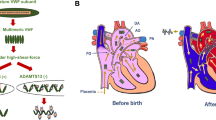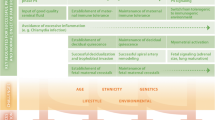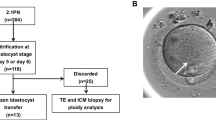Abstract
Recurrent spontaneous abortions (RSA) is defined as three or more consecutive pregnancy losses before 20 weeks of gestation. Various causes of RSA have been identified, still 50% cases remain unexplained after evaluation. One of the causes of unexplained recurrent spontaneous abortions (URSA) is supposed to be the disruption of immunological tolerance at foeta–maternal interface. Regulatory T cells (Tregs) are responsible for the development of immune-tolerant environment at foetal–maternal interface and supports pregnancy. Forkhead/winged helix transcription factor (FOXP3) gene plays an important role in the development and function of Tregs. In URSA, Tregs (CD4+CD25+) are reduced in peripheral blood and decidua of pregnant women. This reduction of Tregs (CD4+CD25+) is associated with decreased expression of FOXP3 gene. This study evaluated the association between single-nucleotide polymorphisms (SNPs) in FOXP3 gene and URSA in Indian population. In this study, 100 patients with a history of URSA and 100 healthy ethnically matched women with at least one normal pregnancy and no abortion were included as case and control groups, respectively. Four SNPs of FOXP3 gene, two in the promoter region: \(-924\hbox {A/G}\) and \(-3279\hbox {C/A}\), and two intronic, \(-20\hbox {G/A}\) and \(+459\hbox {T/C}\), were genotyped by polymerase chain reaction-restriction fragment length polymorphism (PCR-RFLP). \(-924\hbox {A/G}\) and \(+459\hbox {T/C}\) polymorphisms were found to be associated with URSA. \(-3279\hbox {C/A}\) and \(-20\hbox {G/A}\) polymorphism were not found to be associated with URSA. The odds ratio (OR) of mutant allele G for \(-924\hbox {A/G}\) polymorphism was 2.5 (95% CI 1.7–3.8; \(P< 0.001\)) and mutant allele C for \(+459\hbox {T/C}\) polymorphism was 1.7 (95% CI 1.1–2.6; \(P = 0.01\)). For \(-20\hbox {G/A}\) polymorphism, only GG genotype was found in both URSA and controls. These results suggest that \(-924\hbox {A/G}\) and \(+459\hbox {T/C}\) polymorphisms of the FOXP3 gene might be associated with URSA and \(-20\hbox {G/A}\) polymorphism is likely to be rare in Indian population and might not be associated with URSA.
Similar content being viewed by others
References
Andre G. M., Barbosa C. P., Teles J. S., Vilarino F. L., Christofolini D. M. and Bianco B. 2011 Analysis of FOXP3 polymorphisms in infertile womenwith and without endometriosis. Fertil. Steril. 95, 2223–2227.
Bassuny W. M., Ihara K., Sasaki Y., Kuromaru R., Kohno H., Matsuura N. and Hara T. 2003 A functional polymorphism in the promoter/enhancerregion of the FOXP3/Scurfin gene associated with type 1 diabetes. Immunogenetics 55, 149–156.
Naderi-Mahabadi F., Zarei S., Fatemi R., Kamali K., Pahlavanzadeh Z., Jeddi-Tehrani M. et al. 2015 Association study of forkhead box P3 gene polymorphisms with unexplained recurrent spontaneous abortion. J. Reprod. Immunol. 110, 48–53.
Floess S., Freyer J., Siewert C., Baron U., Olek S., Polansky J. et al. 2007 Epigenetic control of the FOXP3 locus inregulatory T cells. PLoS Biol. 5, e38.
Ford H. B. and Schust D. J. 2009 Recurrent pregnancy loss: etiology, diagnosis, and therapy. Rev. Obstet. Gynecol. 2, 76–83.
Gao L., Li K., Li F., Li H., Liu L., Wang L. et al. 2010 Polymorphisms in the FOXP3 gene in Han Chinese psoriasis patients. J. Dermatol. Sci. 57, 51–56.
Inoue N., Watanabe M., Morita M., Tomizawa R., Akamizu T., Tatsumi K. et al. 2010 Association of functional polymorphisms related to the transcriptional level of FOXP3 with prognosis of autoimmune thyroid diseases. Clin. Exp. Immunol. 162, 402–406.
Leber A., Zenclussen M. L., Teles A., Brachwitz N., Casalis P., El-Mousleh T. et al. 2011 Pregnancy: tolerance and suppression of immune responses. Methods Mol. Biol. 677, 397–417.
Li T. C., Makris M., Tomsu M., Tuckerman E. and Laird S. 2002 Recurrent miscarriage: aetiology, management and prognosis. Hum. Reprod. 8, 463–481.
Mei S., Tan J., Chen H., Chen Y. and Zhang J. 2010 Changes of CD4+CD25 highr egulatory T cells and FOXP3 expression in unexplained recurrent spontaneous abortion patients. Fertil. Steril. 94, 2244–2247.
Mold J. E, Michaelsson J, Burt T. D, Muench M. O, Beckerman K. P. and Busch M. P. 2008 Maternal alloantigens promote the development of tolerogenic fetal regulatory T cells in utero. Science 322, 1562e5.
Moyer R. A., Wang D., Papp A. C., Smith R. M., Duque L., Mash D. C. et al 2011 Intronic polymorphisms affecting alternative splicing of human dopamine D2 receptor are associated with cocaine abuse. Neuropsychopharmacology 36, 753–762.
Wang Y., Souabni A., Flavell R. A. and Wan Y. Y. 2010 An intrinsic mechanism predisposes FOXP3-expressing regulatory T cells to Th2 conversion invivo. J. Immunol. 185, 5983–5992.
Williams L. M. and Rudensky A. Y. 2007 Maintenance of the FOXP3-dependent developmental program in mature regulatory T cells requires continued expression of FOXP3. Nat. Immunol. 8, 277–284.
Wu Y., Borde M., Heissmeyer V., Feuerer M., Lapan A. D., Stroud J. C. et al. 2006 FOXP3 controls regulatory T cell function through cooperation with NFAT. Cell 126, 375–387.
Wu Z., You Z., Zhang C., Li Z., Su X., Zhang X. and Li Y. 2012 Association between functional polymorphisms of FOXP3 gene and the occurrence of unexplained recurrent spontaneous abortion in a Chinese Han population. Clin. Dev. Immunol. Article ID 896458.
Yang H., Qiu L., Chen G., Ye Z., Lu C. and Lin Q. 2008 Proportional change of CD4+CD25+ regulatory T cells in decidua and peripheral blood in unexplained recurrent spontaneous abortion patients. Fertil. Steril. 89, 656–661.
Zenclussen A. C., Gerlof K., Zenclussen M. L., Ritschel S., Zambon Bertoja A., Fest S. et al. 2006 Regulatory T cells induce a privileged tolerant microenvironment at the fetal–maternal interface. Eur. J. Immunol. 36, 82–94.
Zhang L., Zhang Y., Desrosiers M., Wang C., Zhao Y. and Han D. 2009 Genetic association study of FOXP3 polymorphisms in allergic rhinitisin a Chinese population. Hum. Immunol. 70, 930–934.
Acknowledgements
We acknowledge the funding from the Indian Council of Medical Research, Government of India, New Delhi, India (grant number 63/8/2010-BMS). We are grateful to the women who enrolled for this study.
Author information
Authors and Affiliations
Corresponding author
Additional information
Corresponding editor: Rajiva Raman
Rights and permissions
About this article
Cite this article
Mishra, S., Srivastava, A., Mandal, K. et al. Study of the association of forkhead box P3 (FOXP3) gene polymorphisms with unexplained recurrent spontaneous abortions in Indian population. J Genet 97, 405–410 (2018). https://doi.org/10.1007/s12041-018-0917-9
Received:
Revised:
Accepted:
Published:
Issue Date:
DOI: https://doi.org/10.1007/s12041-018-0917-9




